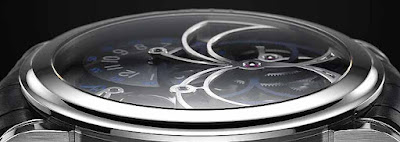 I've been waiting to see more extensive photos of the Cabestan by Vianney Halter and Jean-François Ruchonnet of the DMC Group. So thanks to SuitbertW who just shot these for The Purists. The Cabestan has yet to go into production (as far as I know) and these prototypes seem to be the only existing specimens so far.
I've been waiting to see more extensive photos of the Cabestan by Vianney Halter and Jean-François Ruchonnet of the DMC Group. So thanks to SuitbertW who just shot these for The Purists. The Cabestan has yet to go into production (as far as I know) and these prototypes seem to be the only existing specimens so far.
The rolling barreled displays are powered by chain links and fusee wound by a winding winch!
Mechanical specs below photos;




A spectacular architecture (via
EuropaStar)
This really spectacular architecture seems to be absolutely original. The mechanical design of the Cabestan, including its tourbillon, is totally transversal. The indications (hour, minute, seconds, and power reserve) appear on the cylinders located at the four “corners” of the watch.
Starting from the lower left, we find the barrel, which transmits its driving power to the movement by the intermediary of a chain. This chain is connected to a second cylinder, at the upper left, made up of one part of a fusee (placed horizontally as opposed to the traditional fusees that are always vertical), and the other of the cylindrical power reserve indicator (a total of 72 hours).
Still on the upper end, but this time on the right, we find two cylinders next to each other, providing the perfectly readable hours and minutes. In the lower right hand corner, we can see the tourbillon, which is also placed vertically and is directly linked to another cylinder, which quite logically gives the seconds indication, as the tourbillon makes one rotation per minute.
This completely original mechanical movement, with manual winding, a fusee and a tourbillon, integrates six ball bearings into its operation. It is also water-resistant to 30 metres. The entire movement is visible from above and from the side, under a double sapphire crystal (“Trimaran” model) with three recessed and curved sides, taking the form of a “hood”, all in a very sturdy design.
Winding the watch and setting the hour and minutes are effected using a winding stem in the form of a movable “winch” that links directly to one of the small “capstans” that are found at the four exterior angles of the case: at the upper left, it acts directly on the fusee and, by the intermediary of the chain, allows the barrel to be wound; at the upper right, it acts on the minute cylinder which is connected to that of the hours. The two other small “capstans” are only there for decoration and to complete the aesthetics of the case. Once the small winch is used, it is easily stored in the buckle of the watch’s bracelet.
Related Posts;
The Other CabestanJacob & Co. QuenttinHD3 VulcaniaTag Heuer V4 BeltdriveVianney Halter TrioVianney Halter Antiqua|
Watchismo Blog |
Watchismo Shop |
Email Author |
Subscribe |



















































